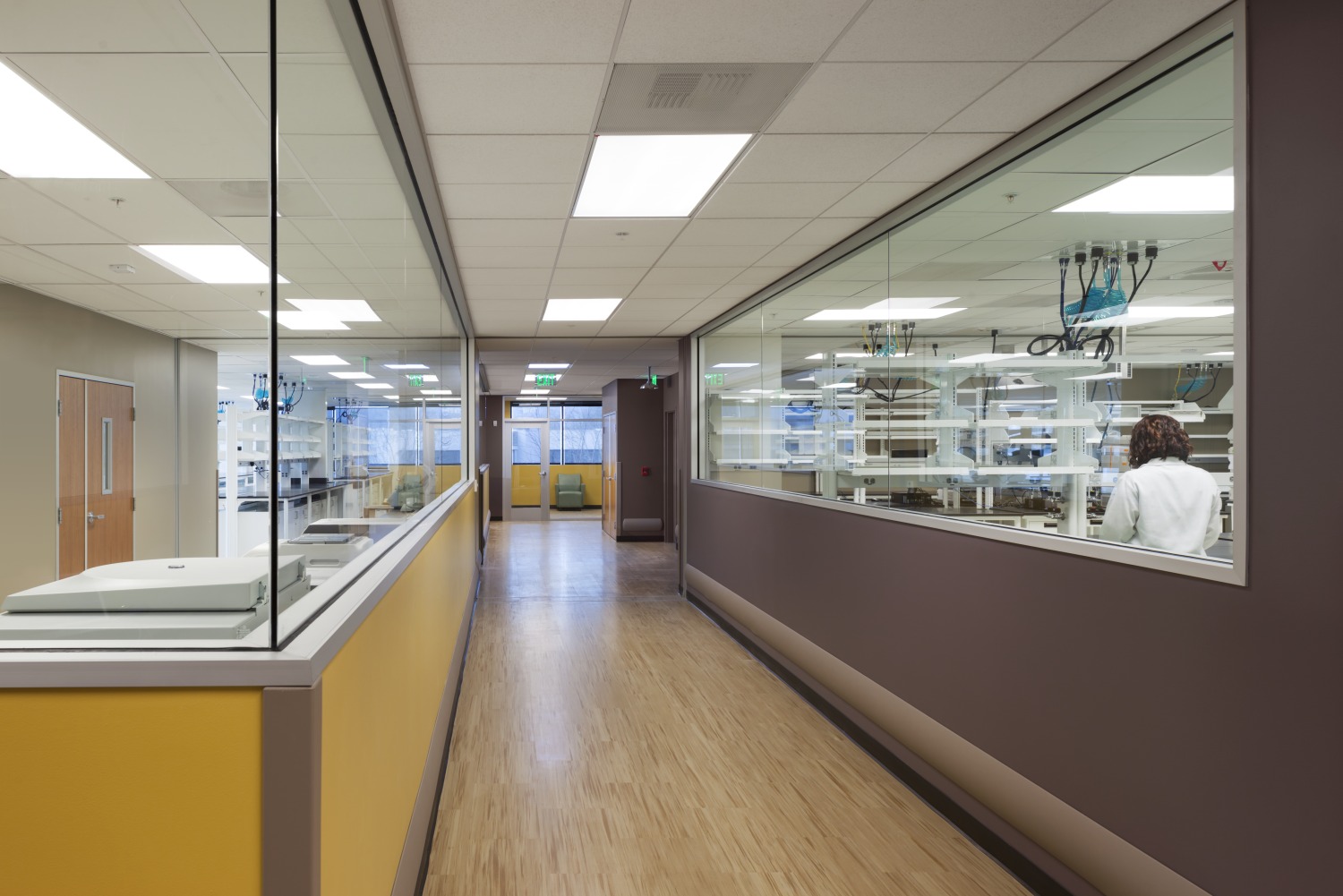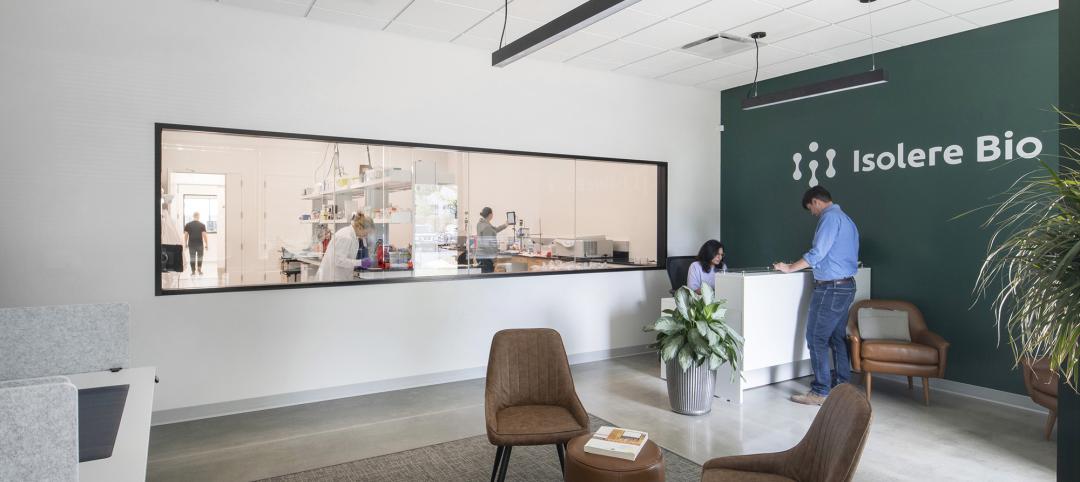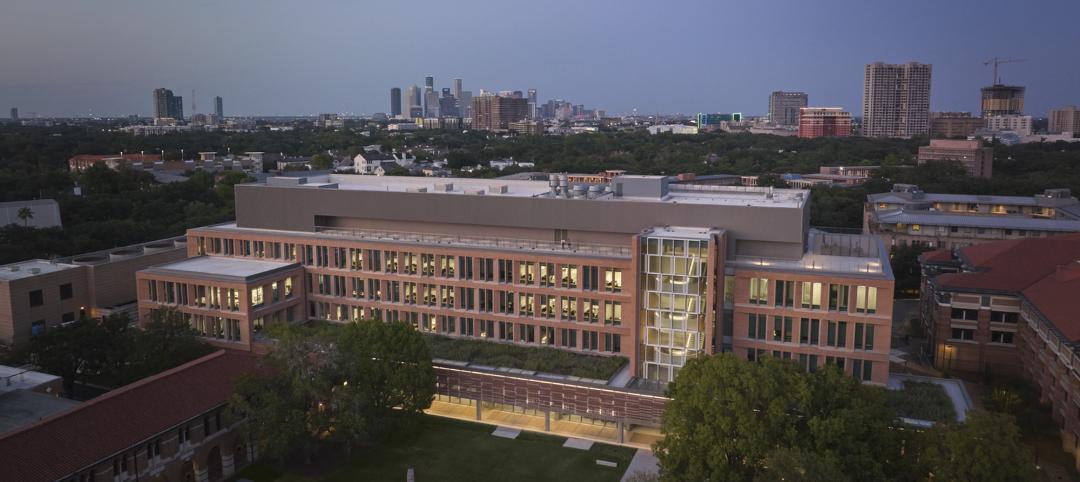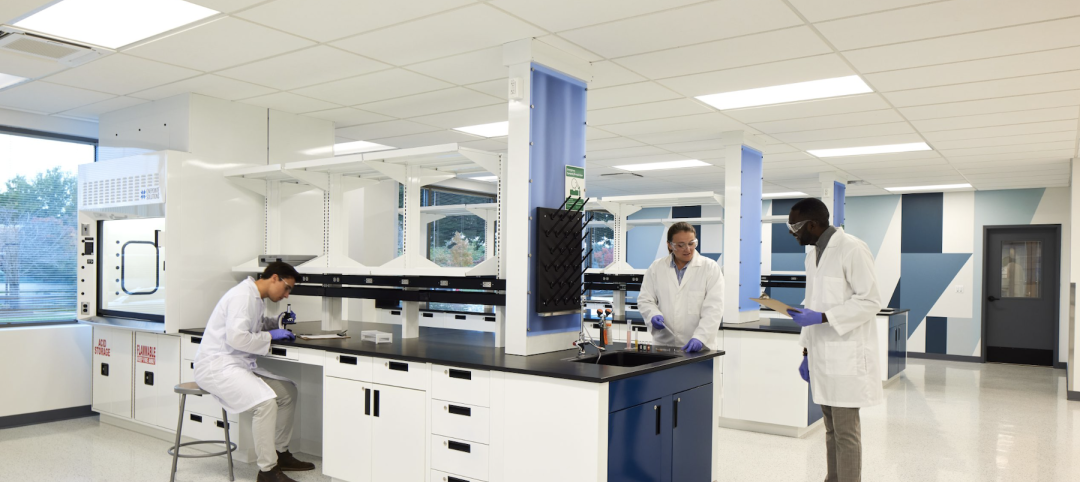Since the onset of the coronavirus pandemic, real estate markets have clearly taken major pivots across the board. From residential adjustments toward the suburbs, the incorporation of safety barriers in public facilities, to major changes in commercial retail and restaurant consumer demands, those of us working in the built environment are seeing trends shift at a pace faster than ever before.
One of the largest trends that is changing the face of real estate is the country’s increasing demand for life sciences and laboratory space. A recent article from Bloomberg noted this increased demand for lab space, pointing to “billions of dollars in institutional investment” that signals a huge shift in how we provide life science space and where.
The demand for life science buildings was increasing before the pandemic thanks to a new generation of Americans with a heightened awareness of health and wellness and the increasing commercialization of University-level science research. The pandemic only accelerated this demand.
The opportunity to absorb this new lab space demand has fallen into the lap of office building owners. With much of the nation still working from home, we have all grown very comfortable with the possibility of the long-term reduction of traditional office space. As a result, this rise in lab demand has a potentially significant intersection with the timing of office vacancies.
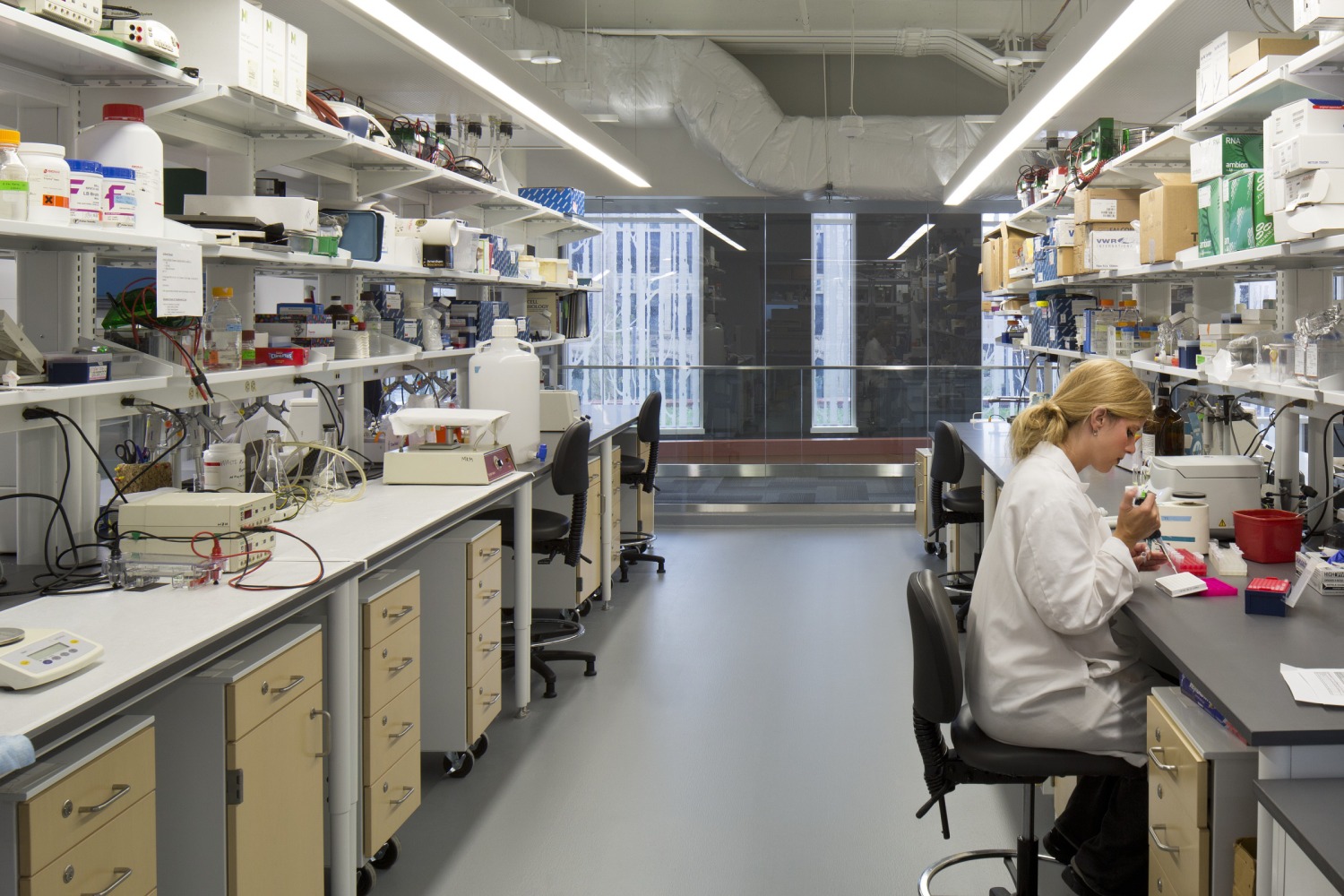
This laboratory at the Wayne State University Biosciences Center, designed by HED, features modular lab units, which can easily be plugged into various positions and swapped out depending on evolving science and research needs. Photo: HED
However, the insertion of life science and laboratory space into traditional office buildings is a bit more complicated than that sort of one-for-one, office-to-office, programmatic replacement. Creating a successful life sciences facility within the shell of a former office building can be much like that old “square peg round hole” paradigm.
So as architects and workplace and laboratory planners with long histories of work with both building types, we wanted to offer some critical, preliminary guidance for building owners and developers to consider when approaching this transition.
8 tips for converting office buildings to life sciences laboratory spaces
1. BUILDING INFRASTRUCTURE
Life science tenants typically need increased primary electrical service, backup generation, and increased water supply infrastructure. So, owners will need to assess what the existing power, water, and sewer line infrastructure supports. Does the existing building currently have fire sprinklers? Does an emergency generator already exist on site? These are critical questions to be answered.
Electrical service should be provided around 25-29 watts per square foot. Whereas office design for power may be around 12-14 watts per square foot. Electrical outlets are also often ceiling-mounted within lab spaces for plug-and-play lab modules, so the wiring infrastructure should support that shift.
Water and sewer services will also need to be increased. Sewer services will likely need to be improved upon because of substances utilized in lab facilities and the chemical safety requirements associated with those. Many older or industrial-oriented spaces are often not sprinklered and, in most cases, they will be required for life sciences activities.
An emergency backup generator is almost always required for life sciences users, whereas in the office sector, generators are typically only found in financial office spaces. If one does not exist on site, a location and size should be determined, and this may require additional structural enhancements.
2. FLOOR-TO-FLOOR HEIGHT
In a laboratory space, duct lines, plumbing lines, and wiring all need to be safely tucked behind dropped ceilings to ensure the sterile nature of the environment and to reduce the potential for spark or dust interactions. This is one of the many reasons why a 16-to-17-foot floor to floor height is ideal for life sciences facilities. This allows enough height for the floor structure and 3 feet of space for HVAC and a dropped ceiling.
There are ways to make an existing low floor-to-floor height work, but most office buildings simply will not have the preferred clearance. However, not impossible, the strategies for designing a life science facility with existing low ceilings can be expensive. So, this issue should be assessed up front and carefully.
3. SPACE PLANNING
What is the existing building’s center-to-center column spacing? Many laboratory bays are designed on an eleven-foot module. Therefore, column spacing that is 22 feet, 33 feet, or 44 feet would be ideal for this conversion—though successful operation is not impossible at other column spacing configurations. This planning arrangement will provide great efficiency for your new user layout, especially for growing life sciences companies looking for modular lease options.
4. ROOF CONDITION AND CAPACITY
What is the condition and construction of the existing roof? Not only can your roof play an important role in the air tightness of your building envelope, but your roof structure is also typically home to your HVAC systems. If HVAC systems need to be added for your new life sciences users, this might mean additional HVAC systems may be located on the roof. Therefore, your roof’s structural capacity will need to be considered. While many roofs are built with additional capacity incorporated into their design, not all are. Structural, in most cases, can reinforce a roof to handle additional required HVAC loads, but owners should also be aware of city zoning and overlays that might enforce height limitations as these rooftop decisions are being made.
5. INSULATION
How well is the building currently insulated? In addition to its important role in temperature control in sensitive laboratory testing, window and wall insulation is also often regulated for the safety of life science spaces. Exterior walls and the roof structure will need to be insulated. If you are considering exterior renovations, the addition of dual-pane glazing might be a major cost to consider.
6. SHIPPING & LOADING ZONES
Unlike in typical office uses, shipping and receiving can be important aspects of laboratory and life science operations. From packaging and distribution of new product to the receipt of lab supplies, a loading dock can be an important criterion for a successful laboratory operation. If considering a multi-tenant building occupancy, careful planning of this loading zone will be even more necessary.
7. OVERALL STRUCTURAL CAPACITY
What is the current floor condition and construction quality? Some life science tenants have considerable equipment loads while others have stringent vibration isolation requirements. Live loads in the neighborhood of 125-150 pounds per square foot will be ideal for laboratory facilities. This is a bit higher than typical office buildings, so builder owners should look into this factor, and its capacity for potential increase in certain zones, early.
8. MECHANICAL COMPLEXITY
The mechanical systems provided within a standard office building are fairly well-known and focused on occupant comfort. Mechanical systems for laboratory spaces are dramatically more complex and might include air vacuum systems, reverse osmosis skids, liquid nitrogen lines, and bulk liquid provision. These all require increased exhaust openings, power access, and lines running throughout the building walls and ceilings. Therefore, the ideal office buildings for life science uses will have significant interior wall and ceiling access points and overall capacity.
These eight areas for consideration are just the beginning of a careful conversion process. We hope that this tool will help as you conduct a quick, preliminary analysis of your existing facility before beginning an appropriate unique, site-specific study for the reuse of your existing office building. With more than 23 million square feet of laboratory design under our belts, these insights should certainly help as you work to cut to the feasibility chase.
ABOUT THE AUTHORS
Leonora Georgeoglou, NCIDQ, LEED AP ID+C | As a design leader with HED, Leonora has a passion for integrating interiors with architecture, utilizing evidence-based design to successfully complete projects. Her work covers a wide range of project and client types from workplace to science facilities to higher education centers. Leonora brings clients’ goals to life through visioning sessions where she identifies, researches and implements innovative design solutions from feasibility studies all the way to interior finish selections.
Dan Ringler, CID | Dan Ringler joined HED in 2020 with over twenty-seven years of experience in the delivery of complex repositioning and adaptive reuse projects. In his Project Director role, Dan leads integrated architectural and engineering design teams to develop and execute effective strategies for quality project execution, primarily in the corporate and commercial sectors. Dan’s industry knowledge and focus on client needs are integral in creating design solutions that benefit investors, developers, building owners, brokers and tenants.
Related Stories
Adaptive Reuse | Mar 7, 2024
3 key considerations when converting a warehouse to a laboratory
Does your warehouse facility fit the profile for a successful laboratory conversion that can demand higher rents and lower vacancy rates? Here are three important considerations to factor before proceeding.
University Buildings | Feb 21, 2024
University design to help meet the demand for health professionals
Virginia Commonwealth University is a Page client, and the Dean of the College of Health Professions took time to talk about a pressing healthcare industry need that schools—and architects—can help address.
Urban Planning | Feb 5, 2024
Lessons learned from 70 years of building cities
As Sasaki looks back on 70 years of practice, we’re also looking to the future of cities. While we can’t predict what will be, we do know the needs of cities are as diverse as their scale, climate, economy, governance, and culture.
Laboratories | Feb 5, 2024
DOE selects design-build team for laboratory focused on clean energy innovation
JE Dunn Construction and SmithGroup will construct the 127,000-sf Energy Materials and Processing at Scale (EMAPS) clean energy laboratory in Colorado to create a direct path from lab-scale innovations to pilot-scale production.
Laboratories | Jan 25, 2024
Tactical issues for renovating university research buildings
Matthew Plecity, AIA, ASLA, Principal, GBBN, highlights the connection between the built environment and laboratory research, and weighs the benefits of renovation vs. new construction.
Laboratories | Jan 22, 2024
Speculative vs purpose-built labs: Pros and cons
Hanbury's George L. Kemper, AIA and R. David Cole, AIA share the unique advantages and challenges of both spec. and purpose-build labs.
University Buildings | Jan 18, 2024
Houston’s Rice University opens the largest research facility on its core campus
Designed by Skidmore, Owings & Merrill (SOM), the 251,400-sf building provides students and researchers with state-of-the-art laboratories, classrooms, offices, and a cafe, in addition to multiple gathering spaces.
Healthcare Facilities | Jan 7, 2024
Two new projects could be economic catalysts for a central New Jersey city
A Cancer Center and Innovation district are under construction and expected to start opening in 2025 in New Brunswick.
Laboratories | Jan 5, 2024
Office conversions are helping to meet the growing demand for life-science space
Ware Malcomb and Rock Creek Property Group led the team that recently completed the adaptive reuse of two office buildings in Maryland.
Mass Timber | Jan 2, 2024
5 ways mass timber will reshape the design of life sciences facilities
Here are five reasons why it has become increasingly evident that mass timber is ready to shape the future of laboratory spaces.


